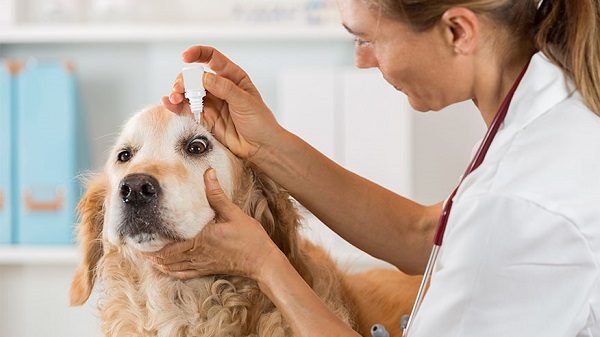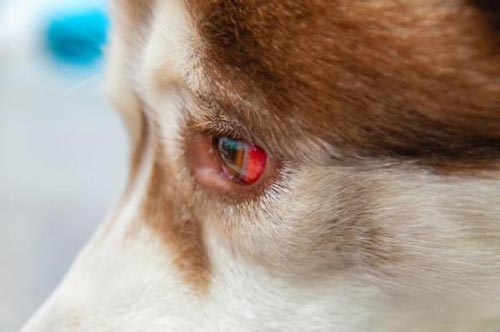Eye pain in dogs is rare, but not unheard of. Let's take a look at some common eye diseases in dogs and how to prevent and treat them.

1. Dogs shed tears continuously due to eye defects
Symptom: Dogs with persistent or frequent watery eyes have a red bump that protrudes below the inner corner of the eye. This sign is more like a deformity than a disease. It most often appears and is encountered in puppies or under 2 years of age.
Reason: In fact, dogs have 3 eyelids, the third eyelid is hidden from view and in the lower inner corner of the eye, this is also where the tear glands are produced. Normally the gland cannot be seen, but in dogs with congenital anomalies it protrudes and may show a red dot under the eye.
Watery eyes in dogs often repeat and can also become the first sign of dangerous diseases caused by inflammation and can be secondary to tumors and swelling. If left untreated, this condition can lead to dry eyes and other complications. If caught early, it can be resolved simply by massaging the criss-crossed eyes of the affected eye, and in some cases the syndrome can resolve on its own.
Treatment:
- Trim the hair around your eyes as often as you feel the hair grows long enough.
- Clean the area around the dog's eyes with physiological saline 0.9% soaked with cotton, wet wipes, or special eye drops as directed by the veterinarian.
- If possible, take your dog for surgery at a reputable veterinary clinic
- If detected early, you can massage the eyes closed diagonally downwards of the affected eye, cool the dog's eyes, combine with the method of short hair trimming, clean around the dog's eyes.
2. Dogs with corneal damage

Symptom: Dog eyes appear lesions, change color in the eyes, or rub and squint because of pain, the dog's eyes may also become red or watery.
Reason: The surface of the eye is covered by a clear tissue called the cornea. The cornea can be damaged, and lacerations, punctures, and sores are all fairly common in dogs. For example, when a dog runs through tall grass, a tree dries up and gets poked in the eye. Other possible causes of corneal damage include:
- Influences from anatomy related to the eye.
- Dog eyes are exposed to soap and chemicals.
- The dog's eyes are infected with harmful insects.
Treatment:
- Trim the long, thick hair around the eyes.
- Do not expose your dog to direct sunlight.
- Clean the dog's eyes with 2% boric acid solution or use physiological saline to wipe around the injured eye.
- Treat eye infections with antibiotic eye drops and ointments.
3. Dogs with dry cornea disease
Symptom: Dogs blink constantly, swollen blood vessels in the eye, swelling of the tissue along the eyelid, even pus draining from the eye. When dogs have dry eyes, their tear glands produce fewer tears than usual. Tears play a role in important functions such as removing potentially harmful foreign objects from the surface of the eye and also nourishing the corneal tissues. A lack of tears can cause problems such as corneal ulcers, chronic discharge, pus from the eye, and eye pain.
Reason:
- Dog inflammation of the lacrimal gland due to abnormal functioning of the body's immune system is the most common, and is often associated with other immune-mediated diseases.
- Chó có đôi mắt lồi như Pug, Shih Tzus, bulldog … dễ bị khô mắt hoặc dễ bị viêm giác mạc hơn các giống chó khác do mí mắt không khép kín khi ngủ.
- Dogs suffer from neurological diseases that affect the activity of the lacrimal gland, often accompanied by dry eyes and dry nose due to effects from the brain.
- Due to side effects from general anesthetic.
Treatment:
- Nếu chó chỉ bị nhẹ có thể xử lý bằng cách thường xuyên nhỏ nước nhỏ mắt nhân tạo – dung dịch bôi trơn dùng để dưỡng ẩm cho đôi mắt, ngừa kích ứng.
- Using cyclosporine ointment stimulates tear production.
- Eye drops with artificial eye drops and Pilocarpine if the dog has nervous dry eyes.
- Take your dog to the vet if it doesn't heal on its own.
4. Dogs with conjunctivitis
Symptom: The conjunctiva is the mucous membrane that covers the inside of a dog's eyelids, both sides of the third eyelid and part of the eyeball. Symptoms of conjunctivitis include red and swollen conjunctiva, watery eyes, and painful, itchy, or rubbing eyes.
Reason: Viêm kết mạc nên được coi là một triệu chứng bệnh, chứ không phải là một bệnh. Nguyên nhân gây ra có thể do kích ứng vật lý như bụi và lông mi mọc vào trong, nhiễm trùng vi khuẩn, virus… và từ các loại côn trùng độc hại, phản ứng dị ứng hóa chất hay xà phòng. Bệnh viêm kết mạc cần được chẩn đoán và điều trị kịp thời bởi nó có thể gây loét giác mạc và mất thị lực.
Treatment:
- Treatment depends on the underlying cause, so there's the right treatment
- When you find that your dog has conjunctivitis, you can gently rinse the eyes with sterile saline to remove eye irritants.
- Bacterial eye infections usually clear up quickly when treated with antibiotic eye drops or ointments. But you need to remember to wash your hands thoroughly with soap before and after applying eye drops to your dog to avoid infection.
- If self-treatment does not help you need to contact your veterinarian.
5. Dogs with glaucoma
Symptom: Dogs with glaucoma eye pain include symptoms of pain, redness, increased tear production, visible raised third eyelid, corneal opacity, dilated pupils, and eyes becoming visibly enlarged. clear (or the pupil does not respond to light when the lamp is passed by). In addition, dogs with glaucoma may also exhibit strange behaviors such as rubbing their head against the wall, refusing to eat, preferring to lie down and not being interested in games.
Reason: In a dog's eye, tear production and drainage are precisely balanced to maintain a constant pressure. Glaucoma occurs when this balance is disrupted and pressure in the eye increases.
Treatment
- Combination therapy of topical and oral anti-inflammatory medications helps to absorb fluid from the eye, causing lower fluid production in the eye while promoting drainage.
- You need to take your dog to the vet for glaucoma treatment to avoid the high risk of blindness to the dog.
6. Dogs with cataracts
Symptom: Dogs are found to have a cloudy membrane in the middle of the pupil of the eye, appear white, gray or milky white spots, the opaque membrane can be large or small. This disease can cause blindness, difficult to treat.
Cause: The lens is the lens in the middle of the eye and it's always clear. But sometimes part or all of the lens suddenly develops, a cloudy film. Cataracts prevent light from reaching the back of the eye leading to poor vision or blindness, depending on the severity of the disease.
Treatment: Currently there is no medicine or procedure to easily cure this serious disease, you need to take your dog to a reputable veterinarian for a specific examination, diagnosis and treatment plan.
7. Dog eyelids roll inward (entropion)
Symptom: Chó có mí mắt cuộn vào trong, gọi là hội chứng “entropion”. Entropion khiến tóc cọ xát trên bề mặt mắt, dẫn đến đau, tăng sản xuất nước mắt và cuối cùng là tổn thương giác mạc.
Reason: Entropion can be a congenital problem but can also develop as a long-term consequence of chronic squinting due to discomfort or scarring of the eyelids.
Treatment: If the entropion is not congenital, your veterinarian may be able to temporarily stitch the eyelids into a more normal position.
8. Dogs with retinal atrophy
Symptom: Progressive retinal atrophy (PRA) is difficult to detect. PRA is also a condition that causes dogs to gradually become blind even though their eyes look normal, showing nothing special. The first symptom of PRA is often difficulty seeing at night, and they are completely normal until vision is almost completely gone.
Cách điều trị: Hiện nay không có phương pháp điều trị hiệu quả nào cho PRA, nhưng tình trạng này không gây đau đớn và …chó thường thích nghi cực kỳ tốt với việc bị mù do chúng còn cái mũi rất thính.
Here is some information on how to handle it when dogs have eye pain that we want to share with you. Wish you have healthy and lovely dogs. If you need to know more about other ways to take care of dogs, please contact http://vanchuyenchomeo.com/ for advice.